Comparing Carotid Massage and Valsalva for SVT: A Literature Review
VerifiedAdded on 2023/06/12
|9
|1590
|389
Literature Review
AI Summary
This literature review critically analyzes the effectiveness of carotid sinus massage (CSM) versus the Valsalva maneuver (VM) as reversion techniques for adult patients experiencing supraventricular tachycardia (SVT) in prehospital settings. The review synthesizes findings from various studies, including systematic reviews and randomized controlled trials, to compare the efficacy and safety of these two non-invasive methods. While one study suggests VM's effectiveness lacks significant evidence, another indicates CSM as a potentially safer first-line defense. The review also highlights the importance of considering patient-specific risks and benefits associated with each technique, particularly the potential for iatrogenic harm with CSM. Ultimately, the review underscores the need for further research to refine the understanding and application of CSM and VM in SVT management. Desklib provides access to this and many other solved assignments and past papers.
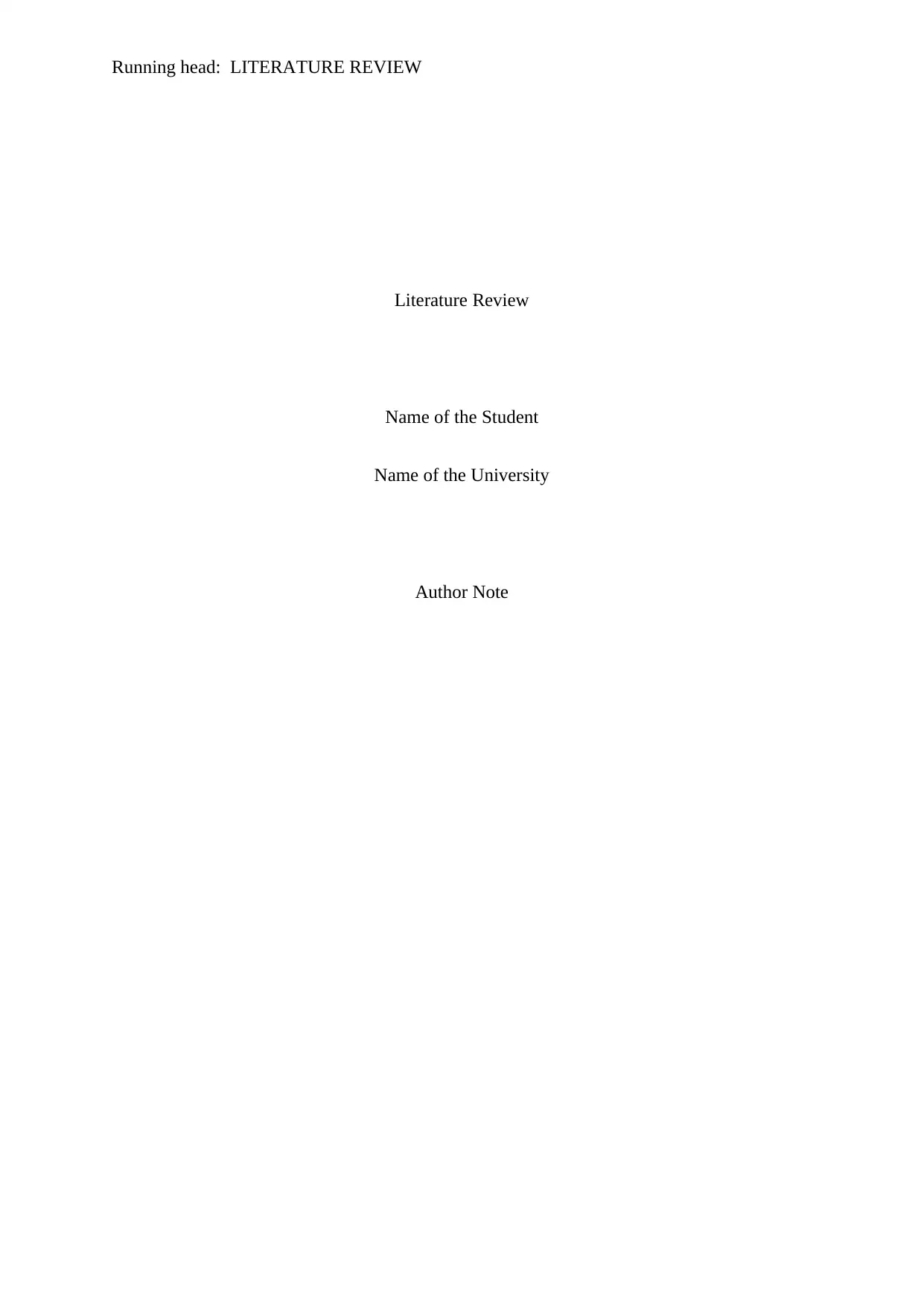
Running head: LITERATURE REVIEW
Literature Review
Name of the Student
Name of the University
Author Note
Literature Review
Name of the Student
Name of the University
Author Note
Paraphrase This Document
Need a fresh take? Get an instant paraphrase of this document with our AI Paraphraser

1
LITERATURE REVIEW
Research Question
How effective is carotid massage as a reversion technique in comparison to the
Valsalva, for adult patients in a prehospital setting experiencing SVT.
Introduction
Supraventricular tachycardia (SVT) is a generic term that is used to describe
tachycardia originating from ventricles. More specifically it can be stated that SVT is used to
define tachycardias which encompass nodal dependent re-entrant circuit like atrioventricular
nodal re-entrant tachycardia (AVNRT) or atrioventricular re-entrant tachycardia (AVRT).
Symptomatic tachycardias are fatal and demands immediate medical attention [1]. Patients
who are suffering from cardiac arrhythmia supraventricular tachycardia (SVT) are generally
present to the healthcare professionals under emergency of pre-hospital settings. Restoration
of the sinus rhythm via reducing SVT deals with increase in the refractoriness of AV nodal
tissue present within myocardium via the application of pharmacological agents or electrical
cardioversion. However, these pharmacological interventions at times are not effective in
generating the desired results and this increases the demand for the other non-vasive
techniques. Among the non-invasive techniques, two of the popular name in the domain of
managing SVT is Valsalva Manoeuvre (VM) and carotid sinus massage (CSM). Both these
techniques help to increase the myocardial refractoriness via increasing the intrathoracic
pressure for a short span of time [2]. However, at present there lack a comparative review of
literature to determine the efficacy of each of the two above mentioned non-invasive
techniques in the domain of treating SVT. Hence the following review of literature aims of
analysis a comparative analysis of two techniques, VM and CSM via citing relevant literary
articles.
LITERATURE REVIEW
Research Question
How effective is carotid massage as a reversion technique in comparison to the
Valsalva, for adult patients in a prehospital setting experiencing SVT.
Introduction
Supraventricular tachycardia (SVT) is a generic term that is used to describe
tachycardia originating from ventricles. More specifically it can be stated that SVT is used to
define tachycardias which encompass nodal dependent re-entrant circuit like atrioventricular
nodal re-entrant tachycardia (AVNRT) or atrioventricular re-entrant tachycardia (AVRT).
Symptomatic tachycardias are fatal and demands immediate medical attention [1]. Patients
who are suffering from cardiac arrhythmia supraventricular tachycardia (SVT) are generally
present to the healthcare professionals under emergency of pre-hospital settings. Restoration
of the sinus rhythm via reducing SVT deals with increase in the refractoriness of AV nodal
tissue present within myocardium via the application of pharmacological agents or electrical
cardioversion. However, these pharmacological interventions at times are not effective in
generating the desired results and this increases the demand for the other non-vasive
techniques. Among the non-invasive techniques, two of the popular name in the domain of
managing SVT is Valsalva Manoeuvre (VM) and carotid sinus massage (CSM). Both these
techniques help to increase the myocardial refractoriness via increasing the intrathoracic
pressure for a short span of time [2]. However, at present there lack a comparative review of
literature to determine the efficacy of each of the two above mentioned non-invasive
techniques in the domain of treating SVT. Hence the following review of literature aims of
analysis a comparative analysis of two techniques, VM and CSM via citing relevant literary
articles.
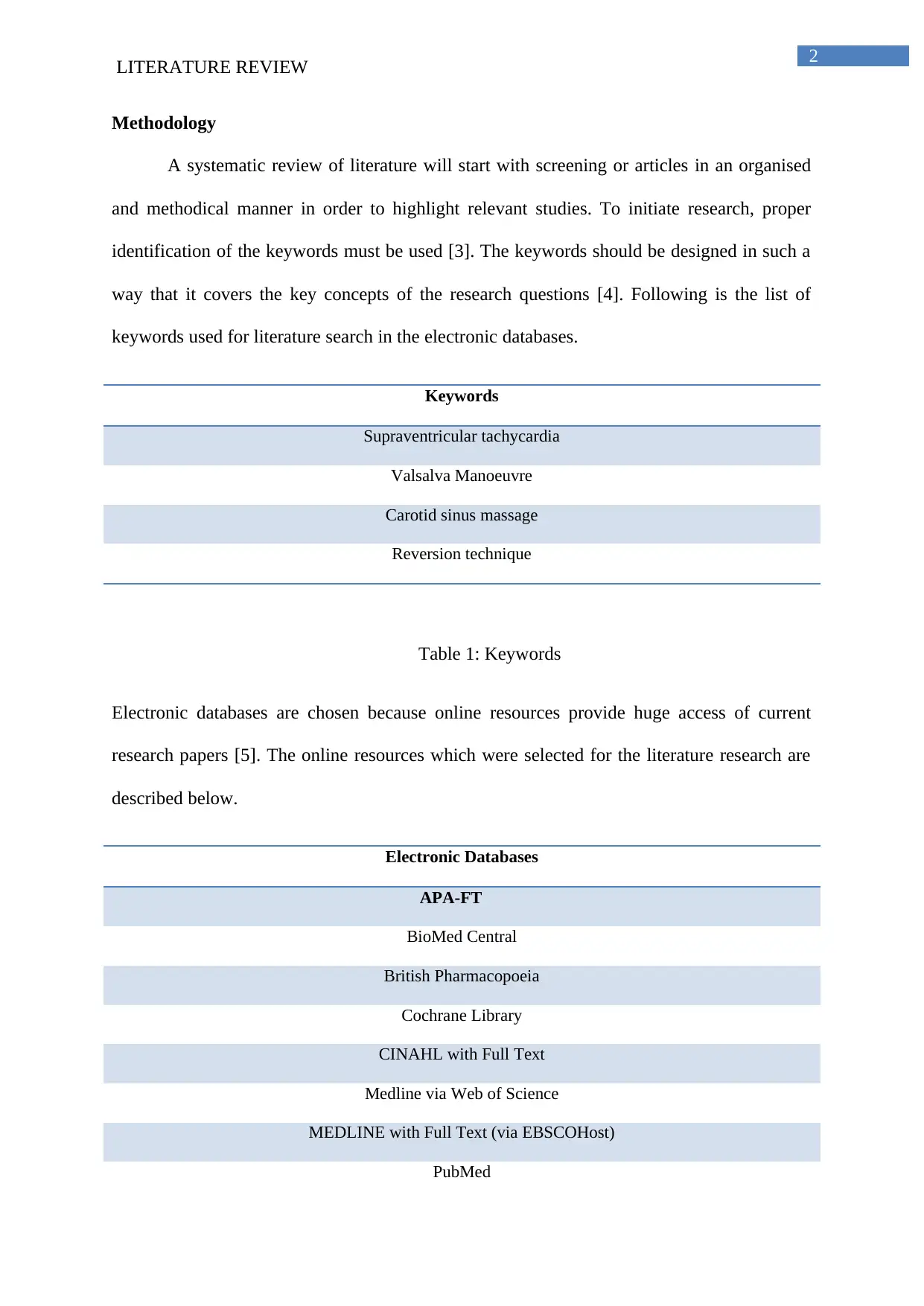
2
LITERATURE REVIEW
Methodology
A systematic review of literature will start with screening or articles in an organised
and methodical manner in order to highlight relevant studies. To initiate research, proper
identification of the keywords must be used [3]. The keywords should be designed in such a
way that it covers the key concepts of the research questions [4]. Following is the list of
keywords used for literature search in the electronic databases.
Keywords
Supraventricular tachycardia
Valsalva Manoeuvre
Carotid sinus massage
Reversion technique
Table 1: Keywords
Electronic databases are chosen because online resources provide huge access of current
research papers [5]. The online resources which were selected for the literature research are
described below.
Electronic Databases
APA-FT
BioMed Central
British Pharmacopoeia
Cochrane Library
CINAHL with Full Text
Medline via Web of Science
MEDLINE with Full Text (via EBSCOHost)
PubMed
LITERATURE REVIEW
Methodology
A systematic review of literature will start with screening or articles in an organised
and methodical manner in order to highlight relevant studies. To initiate research, proper
identification of the keywords must be used [3]. The keywords should be designed in such a
way that it covers the key concepts of the research questions [4]. Following is the list of
keywords used for literature search in the electronic databases.
Keywords
Supraventricular tachycardia
Valsalva Manoeuvre
Carotid sinus massage
Reversion technique
Table 1: Keywords
Electronic databases are chosen because online resources provide huge access of current
research papers [5]. The online resources which were selected for the literature research are
described below.
Electronic Databases
APA-FT
BioMed Central
British Pharmacopoeia
Cochrane Library
CINAHL with Full Text
Medline via Web of Science
MEDLINE with Full Text (via EBSCOHost)
PubMed
⊘ This is a preview!⊘
Do you want full access?
Subscribe today to unlock all pages.

Trusted by 1+ million students worldwide
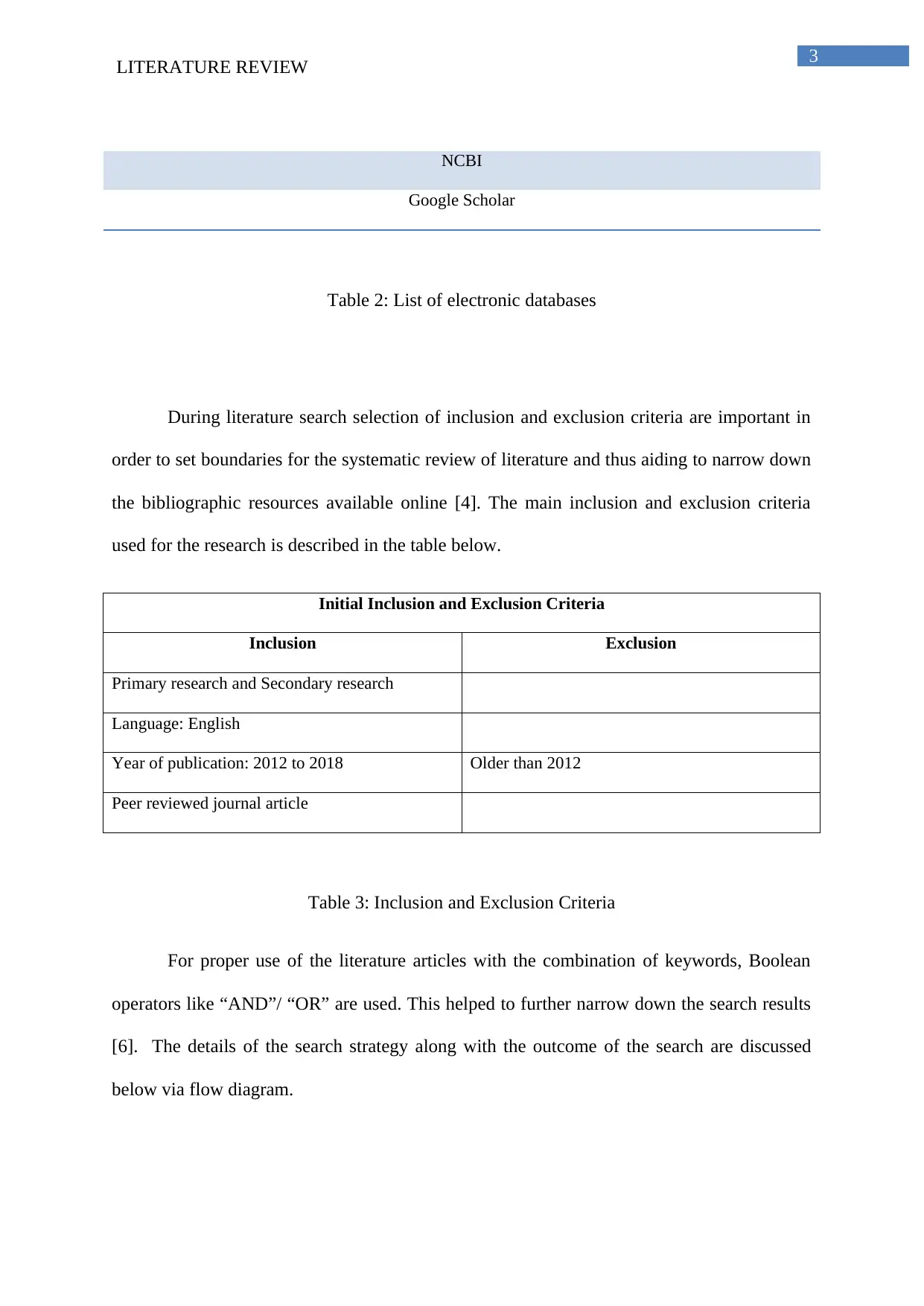
3
LITERATURE REVIEW
NCBI
Google Scholar
Table 2: List of electronic databases
During literature search selection of inclusion and exclusion criteria are important in
order to set boundaries for the systematic review of literature and thus aiding to narrow down
the bibliographic resources available online [4]. The main inclusion and exclusion criteria
used for the research is described in the table below.
Initial Inclusion and Exclusion Criteria
Inclusion Exclusion
Primary research and Secondary research
Language: English
Year of publication: 2012 to 2018 Older than 2012
Peer reviewed journal article
Table 3: Inclusion and Exclusion Criteria
For proper use of the literature articles with the combination of keywords, Boolean
operators like “AND”/ “OR” are used. This helped to further narrow down the search results
[6]. The details of the search strategy along with the outcome of the search are discussed
below via flow diagram.
LITERATURE REVIEW
NCBI
Google Scholar
Table 2: List of electronic databases
During literature search selection of inclusion and exclusion criteria are important in
order to set boundaries for the systematic review of literature and thus aiding to narrow down
the bibliographic resources available online [4]. The main inclusion and exclusion criteria
used for the research is described in the table below.
Initial Inclusion and Exclusion Criteria
Inclusion Exclusion
Primary research and Secondary research
Language: English
Year of publication: 2012 to 2018 Older than 2012
Peer reviewed journal article
Table 3: Inclusion and Exclusion Criteria
For proper use of the literature articles with the combination of keywords, Boolean
operators like “AND”/ “OR” are used. This helped to further narrow down the search results
[6]. The details of the search strategy along with the outcome of the search are discussed
below via flow diagram.
Paraphrase This Document
Need a fresh take? Get an instant paraphrase of this document with our AI Paraphraser

4
LITERATURE REVIEW
Records identified through
database searching
(n = 30)
Screening
Included
Eligibility
Identification
Additional records identified
through other sources
(n = 50)
Records after duplicates removed
(n =25 )
Records screened
(n = 25)
Records excluded
(n = 10)
Full-text articles assessed for eligibility
(n = 15)
Full-text articles excluded,
with reasons
(n = 13 )
Studies included in
qualitative synthesis
(meta-analysis)
(n = 2)
LITERATURE REVIEW
Records identified through
database searching
(n = 30)
Screening
Included
Eligibility
Identification
Additional records identified
through other sources
(n = 50)
Records after duplicates removed
(n =25 )
Records screened
(n = 25)
Records excluded
(n = 10)
Full-text articles assessed for eligibility
(n = 15)
Full-text articles excluded,
with reasons
(n = 13 )
Studies included in
qualitative synthesis
(meta-analysis)
(n = 2)
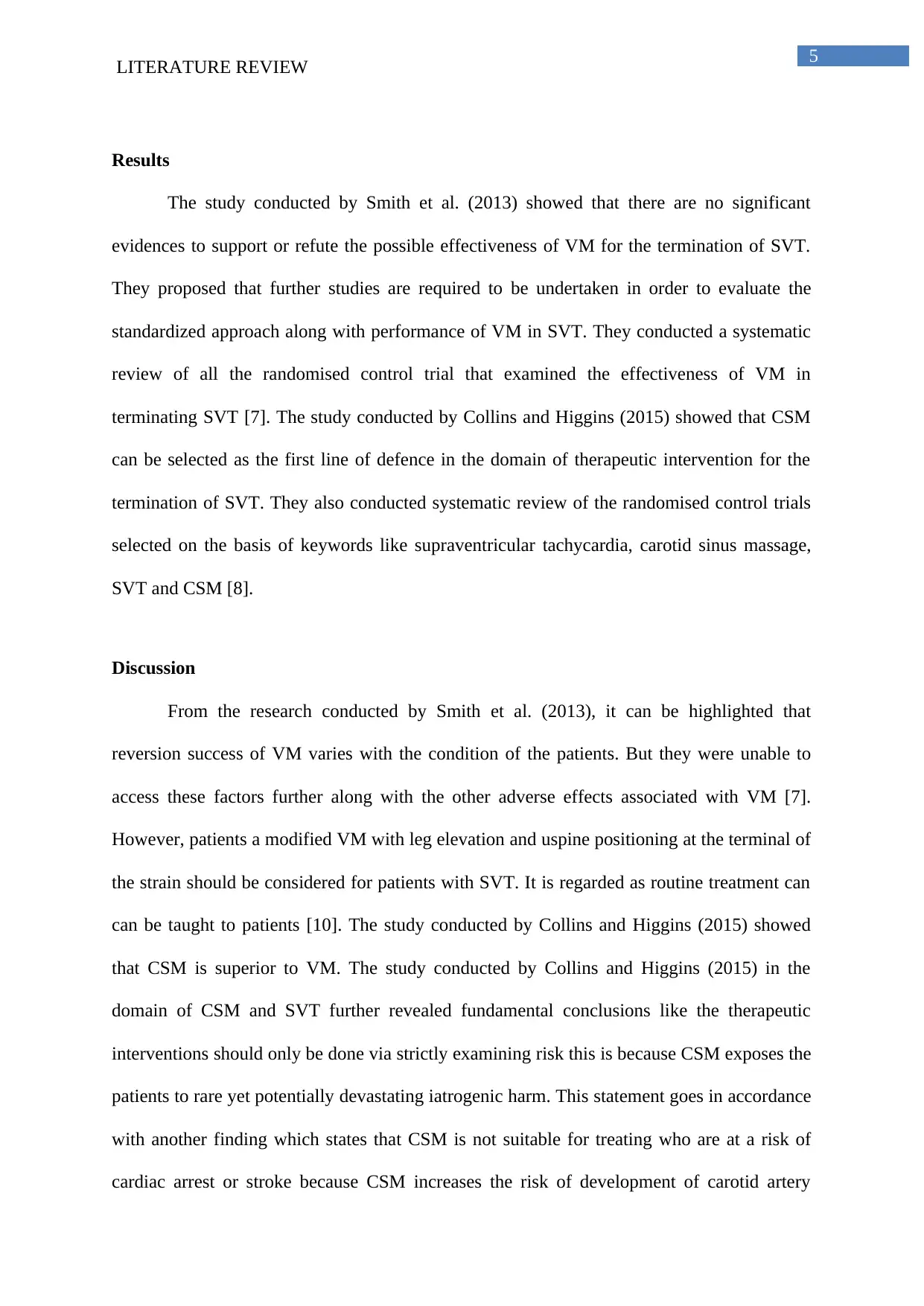
5
LITERATURE REVIEW
Results
The study conducted by Smith et al. (2013) showed that there are no significant
evidences to support or refute the possible effectiveness of VM for the termination of SVT.
They proposed that further studies are required to be undertaken in order to evaluate the
standardized approach along with performance of VM in SVT. They conducted a systematic
review of all the randomised control trial that examined the effectiveness of VM in
terminating SVT [7]. The study conducted by Collins and Higgins (2015) showed that CSM
can be selected as the first line of defence in the domain of therapeutic intervention for the
termination of SVT. They also conducted systematic review of the randomised control trials
selected on the basis of keywords like supraventricular tachycardia, carotid sinus massage,
SVT and CSM [8].
Discussion
From the research conducted by Smith et al. (2013), it can be highlighted that
reversion success of VM varies with the condition of the patients. But they were unable to
access these factors further along with the other adverse effects associated with VM [7].
However, patients a modified VM with leg elevation and uspine positioning at the terminal of
the strain should be considered for patients with SVT. It is regarded as routine treatment can
can be taught to patients [10]. The study conducted by Collins and Higgins (2015) showed
that CSM is superior to VM. The study conducted by Collins and Higgins (2015) in the
domain of CSM and SVT further revealed fundamental conclusions like the therapeutic
interventions should only be done via strictly examining risk this is because CSM exposes the
patients to rare yet potentially devastating iatrogenic harm. This statement goes in accordance
with another finding which states that CSM is not suitable for treating who are at a risk of
cardiac arrest or stroke because CSM increases the risk of development of carotid artery
LITERATURE REVIEW
Results
The study conducted by Smith et al. (2013) showed that there are no significant
evidences to support or refute the possible effectiveness of VM for the termination of SVT.
They proposed that further studies are required to be undertaken in order to evaluate the
standardized approach along with performance of VM in SVT. They conducted a systematic
review of all the randomised control trial that examined the effectiveness of VM in
terminating SVT [7]. The study conducted by Collins and Higgins (2015) showed that CSM
can be selected as the first line of defence in the domain of therapeutic intervention for the
termination of SVT. They also conducted systematic review of the randomised control trials
selected on the basis of keywords like supraventricular tachycardia, carotid sinus massage,
SVT and CSM [8].
Discussion
From the research conducted by Smith et al. (2013), it can be highlighted that
reversion success of VM varies with the condition of the patients. But they were unable to
access these factors further along with the other adverse effects associated with VM [7].
However, patients a modified VM with leg elevation and uspine positioning at the terminal of
the strain should be considered for patients with SVT. It is regarded as routine treatment can
can be taught to patients [10]. The study conducted by Collins and Higgins (2015) showed
that CSM is superior to VM. The study conducted by Collins and Higgins (2015) in the
domain of CSM and SVT further revealed fundamental conclusions like the therapeutic
interventions should only be done via strictly examining risk this is because CSM exposes the
patients to rare yet potentially devastating iatrogenic harm. This statement goes in accordance
with another finding which states that CSM is not suitable for treating who are at a risk of
cardiac arrest or stroke because CSM increases the risk of development of carotid artery
⊘ This is a preview!⊘
Do you want full access?
Subscribe today to unlock all pages.

Trusted by 1+ million students worldwide
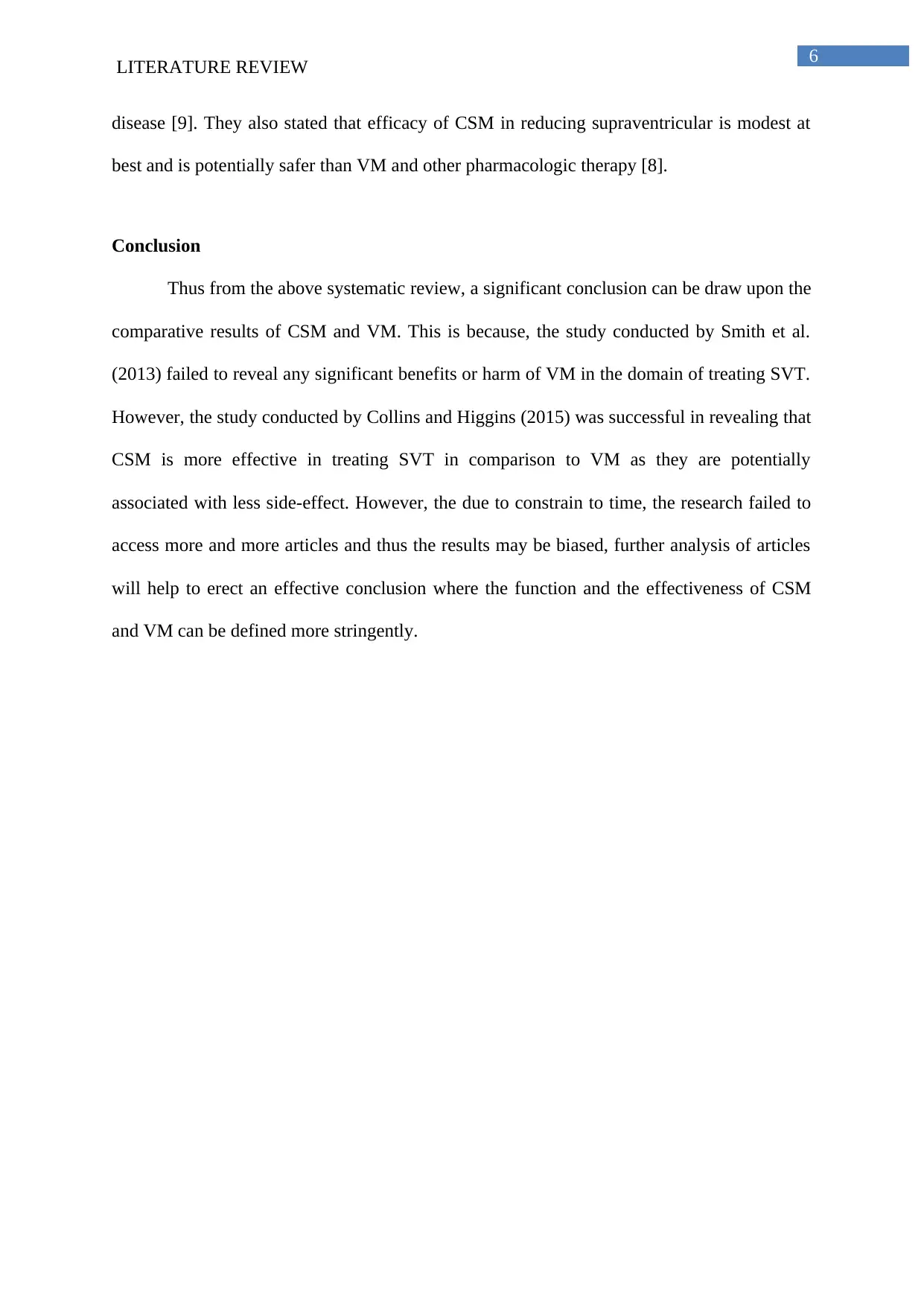
6
LITERATURE REVIEW
disease [9]. They also stated that efficacy of CSM in reducing supraventricular is modest at
best and is potentially safer than VM and other pharmacologic therapy [8].
Conclusion
Thus from the above systematic review, a significant conclusion can be draw upon the
comparative results of CSM and VM. This is because, the study conducted by Smith et al.
(2013) failed to reveal any significant benefits or harm of VM in the domain of treating SVT.
However, the study conducted by Collins and Higgins (2015) was successful in revealing that
CSM is more effective in treating SVT in comparison to VM as they are potentially
associated with less side-effect. However, the due to constrain to time, the research failed to
access more and more articles and thus the results may be biased, further analysis of articles
will help to erect an effective conclusion where the function and the effectiveness of CSM
and VM can be defined more stringently.
LITERATURE REVIEW
disease [9]. They also stated that efficacy of CSM in reducing supraventricular is modest at
best and is potentially safer than VM and other pharmacologic therapy [8].
Conclusion
Thus from the above systematic review, a significant conclusion can be draw upon the
comparative results of CSM and VM. This is because, the study conducted by Smith et al.
(2013) failed to reveal any significant benefits or harm of VM in the domain of treating SVT.
However, the study conducted by Collins and Higgins (2015) was successful in revealing that
CSM is more effective in treating SVT in comparison to VM as they are potentially
associated with less side-effect. However, the due to constrain to time, the research failed to
access more and more articles and thus the results may be biased, further analysis of articles
will help to erect an effective conclusion where the function and the effectiveness of CSM
and VM can be defined more stringently.
Paraphrase This Document
Need a fresh take? Get an instant paraphrase of this document with our AI Paraphraser
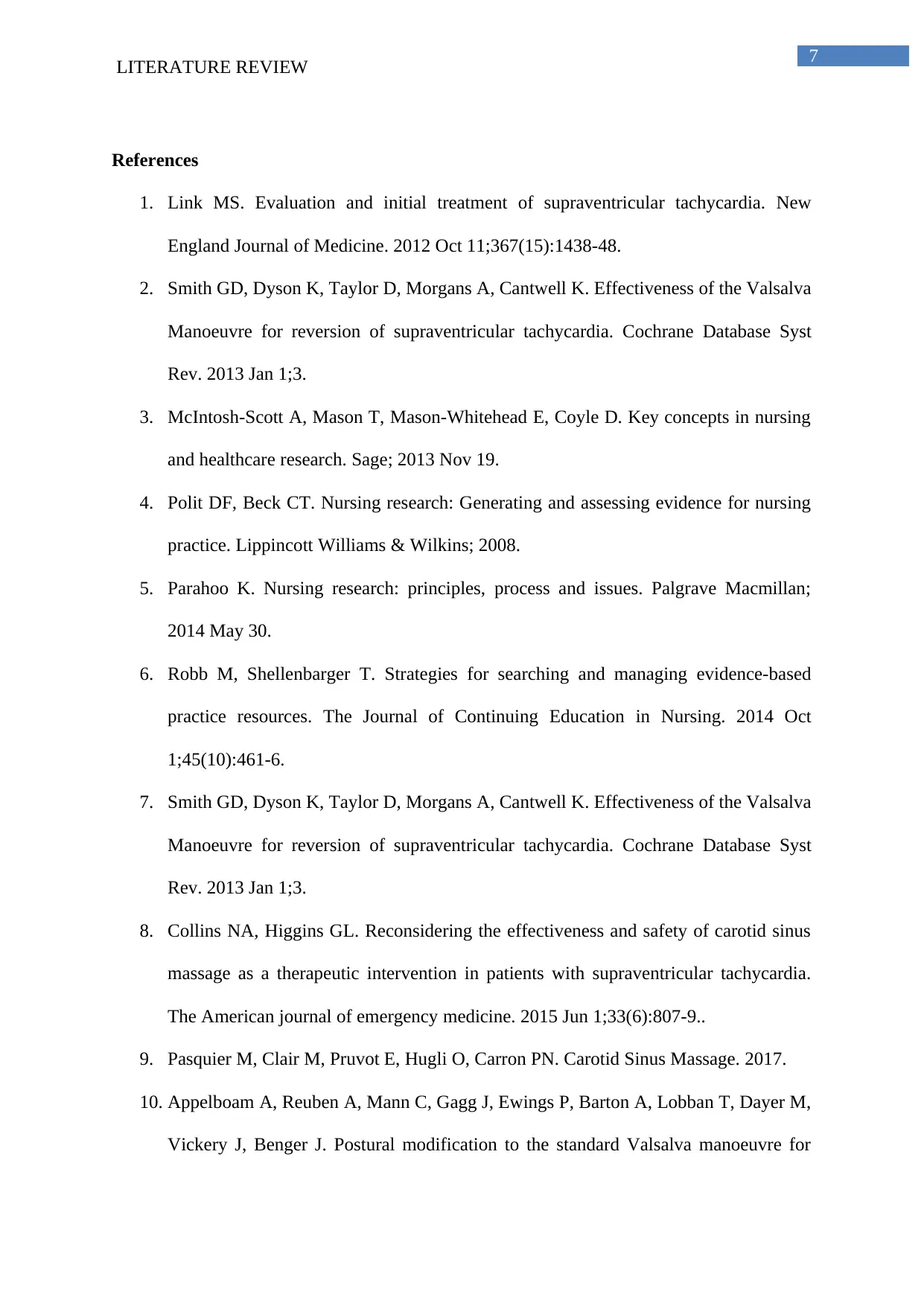
7
LITERATURE REVIEW
References
1. Link MS. Evaluation and initial treatment of supraventricular tachycardia. New
England Journal of Medicine. 2012 Oct 11;367(15):1438-48.
2. Smith GD, Dyson K, Taylor D, Morgans A, Cantwell K. Effectiveness of the Valsalva
Manoeuvre for reversion of supraventricular tachycardia. Cochrane Database Syst
Rev. 2013 Jan 1;3.
3. McIntosh-Scott A, Mason T, Mason-Whitehead E, Coyle D. Key concepts in nursing
and healthcare research. Sage; 2013 Nov 19.
4. Polit DF, Beck CT. Nursing research: Generating and assessing evidence for nursing
practice. Lippincott Williams & Wilkins; 2008.
5. Parahoo K. Nursing research: principles, process and issues. Palgrave Macmillan;
2014 May 30.
6. Robb M, Shellenbarger T. Strategies for searching and managing evidence-based
practice resources. The Journal of Continuing Education in Nursing. 2014 Oct
1;45(10):461-6.
7. Smith GD, Dyson K, Taylor D, Morgans A, Cantwell K. Effectiveness of the Valsalva
Manoeuvre for reversion of supraventricular tachycardia. Cochrane Database Syst
Rev. 2013 Jan 1;3.
8. Collins NA, Higgins GL. Reconsidering the effectiveness and safety of carotid sinus
massage as a therapeutic intervention in patients with supraventricular tachycardia.
The American journal of emergency medicine. 2015 Jun 1;33(6):807-9..
9. Pasquier M, Clair M, Pruvot E, Hugli O, Carron PN. Carotid Sinus Massage. 2017.
10. Appelboam A, Reuben A, Mann C, Gagg J, Ewings P, Barton A, Lobban T, Dayer M,
Vickery J, Benger J. Postural modification to the standard Valsalva manoeuvre for
LITERATURE REVIEW
References
1. Link MS. Evaluation and initial treatment of supraventricular tachycardia. New
England Journal of Medicine. 2012 Oct 11;367(15):1438-48.
2. Smith GD, Dyson K, Taylor D, Morgans A, Cantwell K. Effectiveness of the Valsalva
Manoeuvre for reversion of supraventricular tachycardia. Cochrane Database Syst
Rev. 2013 Jan 1;3.
3. McIntosh-Scott A, Mason T, Mason-Whitehead E, Coyle D. Key concepts in nursing
and healthcare research. Sage; 2013 Nov 19.
4. Polit DF, Beck CT. Nursing research: Generating and assessing evidence for nursing
practice. Lippincott Williams & Wilkins; 2008.
5. Parahoo K. Nursing research: principles, process and issues. Palgrave Macmillan;
2014 May 30.
6. Robb M, Shellenbarger T. Strategies for searching and managing evidence-based
practice resources. The Journal of Continuing Education in Nursing. 2014 Oct
1;45(10):461-6.
7. Smith GD, Dyson K, Taylor D, Morgans A, Cantwell K. Effectiveness of the Valsalva
Manoeuvre for reversion of supraventricular tachycardia. Cochrane Database Syst
Rev. 2013 Jan 1;3.
8. Collins NA, Higgins GL. Reconsidering the effectiveness and safety of carotid sinus
massage as a therapeutic intervention in patients with supraventricular tachycardia.
The American journal of emergency medicine. 2015 Jun 1;33(6):807-9..
9. Pasquier M, Clair M, Pruvot E, Hugli O, Carron PN. Carotid Sinus Massage. 2017.
10. Appelboam A, Reuben A, Mann C, Gagg J, Ewings P, Barton A, Lobban T, Dayer M,
Vickery J, Benger J. Postural modification to the standard Valsalva manoeuvre for

8
LITERATURE REVIEW
emergency treatment of supraventricular tachycardias (REVERT): a randomised
controlled trial. The Lancet. 2015 Oct 31;386(10005):1747-53.
LITERATURE REVIEW
emergency treatment of supraventricular tachycardias (REVERT): a randomised
controlled trial. The Lancet. 2015 Oct 31;386(10005):1747-53.
⊘ This is a preview!⊘
Do you want full access?
Subscribe today to unlock all pages.

Trusted by 1+ million students worldwide
1 out of 9
Your All-in-One AI-Powered Toolkit for Academic Success.
+13062052269
info@desklib.com
Available 24*7 on WhatsApp / Email
![[object Object]](/_next/static/media/star-bottom.7253800d.svg)
Unlock your academic potential
Copyright © 2020–2025 A2Z Services. All Rights Reserved. Developed and managed by ZUCOL.